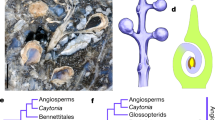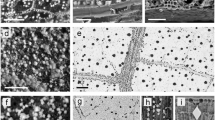Abstract
Lagenostomalean-type seeds in bifurcating cupule systems have been discovered in the late Devonian Hampshire Formation of Randolph County, West Virginia, USA (Fig. 1). The associated megaflora, plants from coal balls, and vertebrate and invertebrate faunas demonstrate that the material is Famennian; the microflora indicates a more specific Fa2c age. Consequently, these seeds predate Archaeosperma arnoldii1 from the Fa2d of northeastern Pennsylvania, the oldest previously reported seed. By applying precision fracture, transfer, dégagement, and thin-section techniques to selected cupules from the more than 100 specimens on hand, we have determined the three-dimensional morphology and histology of the seeds (Fig. 2a–h, k) and cupule systems. A comparison with known late Devonian to early Carboniferous seeds reveals that ours are more primitively organized than all except Genomosperma2,3.
This is a preview of subscription content, access via your institution
Access options
Subscribe to this journal
Receive 51 print issues and online access
$199.00 per year
only $3.90 per issue
Buy this article
- Purchase on Springer Link
- Instant access to full article PDF
Prices may be subject to local taxes which are calculated during checkout
Similar content being viewed by others
References
Pettitt, J. M. & Beck, C. B. Contr. Mus. Paleont. Univ. Mich. 22, 139–154 (1968).
Taylor, T. N. & Millay, M. A. Rev. Palaeobot. Palynol. 27, 329–355 (1979).
Andrews, H. N. Science 142, 925–931 (1963).
Stockmans, F. Mém. r. Hist. nat. Belg. 110, 1–85 (1948).
Matten, L. C., Lacey, W. S., May, B. I. & Lucas, R. C. Rev. Palaebot. Palynol. 29, 241–251 (1980).
Matten, L. C., Lacey, W. S. & Lucas, R. C. Bot. J. Linn. Soc. 81, 249–273 (1980).
Barnard, P. D. W. & Long, A. G. Trans. R. Soc. Edinb. 69, 91–108 (1973).
Mamay, S. H. & Yochelson, E. L. U.S. geol. Surv. Prof. Pap. 354, 193–224 (1962).
Oliver, W. A., DeWitt, W., Dennison, J. M., Hoskins, D. M. & Huddle, J. W. Int. Symp. Dev. Syst. 1, 1001–1040 (1968).
Banks, H. P. in Biostratigraphy of Fossil Plants: Successional and Paleoecological Analyses (eds Dilcher, D. L. & Taylor, T. N.) 1–24 (Dowden, Hutchinson & Ross, Pennsylvania, 1980).
Andrews, H. N. & Phillips, T. L. Bot. J. Linn. Soc. 61, 37–64 (1968).
Phillips, T. L., Andrews, H. N. & Gensel, P. G. Palaeontographica B139, 47–71 (1972).
Clendening, J. A., Eames, L. E. & Wood, G. D. Palynology 4, 15–22 (1980).
Clayton, G., Graham, J. R., Higgs, K., Holland, C. H. & Naylor, D. J. Earth Sci. R. Dubl. Soc. 2, 161–183 (1980).
Scott, A. C. Syst. Ass. Spec. Vol. 15, 87–115 (1980).
Van der Zwan, C. J. Rev. Palaeobot. Palynol. 30, 165–286 (1980).
Chaloner, W. G., Hill, A. J. & Lacey, W. S. Nature 265, 233–235 (1977).
Author information
Authors and Affiliations
Rights and permissions
About this article
Cite this article
Gillespie, W., Rothwell, G. & Scheckler, S. The earliest seeds. Nature 293, 462–464 (1981). https://doi.org/10.1038/293462a0
Received:
Accepted:
Issue Date:
DOI: https://doi.org/10.1038/293462a0
This article is cited by
-
Winged Late Devonian seeds
Nature (1992)
-
Seed size, pollination costs and angiosperm success
Evolutionary Ecology (1991)
-
A primitive seed-like structure and its implications for early gymnosperm evolution
Nature (1989)
-
Gymnosperm Phylogeny — A commentary on the views of S. V. Meyen
The Botanical Review (1985)
-
A critical review of S. V. Meyen’s “Basic features of gymnosperm systematics and phylogeny as evidenced by the fossil record”
The Botanical Review (1985)
Comments
By submitting a comment you agree to abide by our Terms and Community Guidelines. If you find something abusive or that does not comply with our terms or guidelines please flag it as inappropriate.



